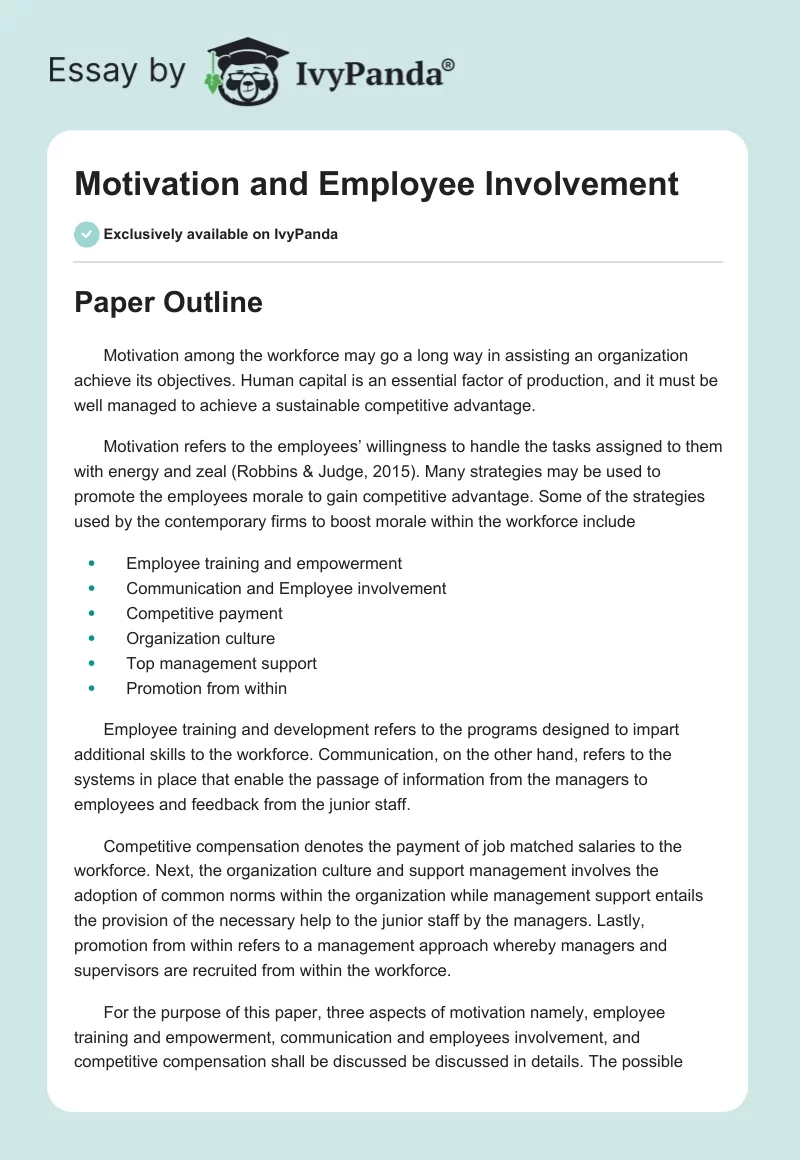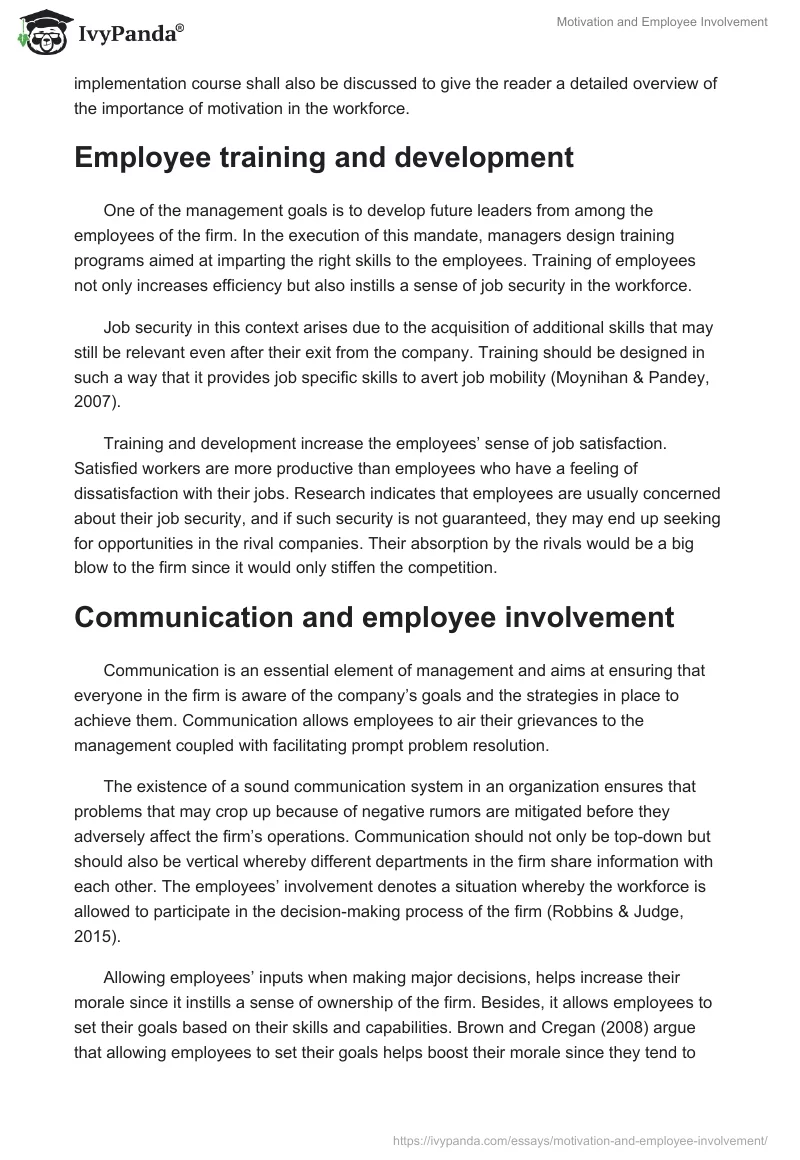Paper Outline
Motivation among the workforce may go a long way in assisting an organization achieve its objectives. Human capital is an essential factor of production, and it must be well managed to achieve a sustainable competitive advantage.
Motivation refers to the employees’ willingness to handle the tasks assigned to them with energy and zeal (Robbins & Judge, 2015). Many strategies may be used to promote the employees morale to gain competitive advantage. Some of the strategies used by the contemporary firms to boost morale within the workforce include
- Employee training and empowerment
- Communication and Employee involvement
- Competitive payment
- Organization culture
- Top management support
- Promotion from within
Employee training and development refers to the programs designed to impart additional skills to the workforce. Communication, on the other hand, refers to the systems in place that enable the passage of information from the managers to employees and feedback from the junior staff.
Competitive compensation denotes the payment of job matched salaries to the workforce. Next, the organization culture and support management involves the adoption of common norms within the organization while management support entails the provision of the necessary help to the junior staff by the managers. Lastly, promotion from within refers to a management approach whereby managers and supervisors are recruited from within the workforce.
For the purpose of this paper, three aspects of motivation namely, employee training and empowerment, communication and employees involvement, and competitive compensation shall be discussed be discussed in details. The possible implementation course shall also be discussed to give the reader a detailed overview of the importance of motivation in the workforce.
Employee training and development
One of the management goals is to develop future leaders from among the employees of the firm. In the execution of this mandate, managers design training programs aimed at imparting the right skills to the employees. Training of employees not only increases efficiency but also instills a sense of job security in the workforce.
Job security in this context arises due to the acquisition of additional skills that may still be relevant even after their exit from the company. Training should be designed in such a way that it provides job specific skills to avert job mobility (Moynihan & Pandey, 2007).
Training and development increase the employees’ sense of job satisfaction. Satisfied workers are more productive than employees who have a feeling of dissatisfaction with their jobs. Research indicates that employees are usually concerned about their job security, and if such security is not guaranteed, they may end up seeking for opportunities in the rival companies. Their absorption by the rivals would be a big blow to the firm since it would only stiffen the competition.
Communication and employee involvement
Communication is an essential element of management and aims at ensuring that everyone in the firm is aware of the company’s goals and the strategies in place to achieve them. Communication allows employees to air their grievances to the management coupled with facilitating prompt problem resolution.
The existence of a sound communication system in an organization ensures that problems that may crop up because of negative rumors are mitigated before they adversely affect the firm’s operations. Communication should not only be top-down but should also be vertical whereby different departments in the firm share information with each other. The employees’ involvement denotes a situation whereby the workforce is allowed to participate in the decision-making process of the firm (Robbins & Judge, 2015).
Allowing employees’ inputs when making major decisions, helps increase their morale since it instills a sense of ownership of the firm. Besides, it allows employees to set their goals based on their skills and capabilities. Brown and Cregan (2008) argue that allowing employees to set their goals helps boost their morale since they tend to feel comfortable working on goals they have set for themselves. Additionally, it helps avert resistance that may come due to non-involvement in decision-making.
Changes work well when every stakeholder in the organization is allowed to participate in formulating the change policies as opposed to a situation whereby the managers are the sole decision makers.
Competitive compensation
Zhang and Bartol (2010) define competitive salary as that which is not less than that paid by the rivals to employees of the same capacity in a firm of similar size. Firms should pay their employees competitive salaries to prevent their absorption by the rival firms in the industry.
In the contemporary business environment, competition is stiff and firms are exploiting every opportunity present to increase their competitive advantage. Most firms have realized the importance of the workforce in building a sustainable competitive advantage over the rivals.
Paying salaries is a sure way of ensuring that the employees are motivated to achieve the objectives of the firm. Rewarding employees competitively also averts staff turnover. Research indicates that better salaries motivate a majority of employees to leave their current jobs (Griffin & Moorhead, 2011). In that regard, firms must harmonize the salaries of their staff to align with that paid by the rivals.
Possible implementation courses
The firm should embark on research to find out the amount of salaries paid to employees of different levels in the rival companies. Based on the findings from the research, the firm should adjust the salaries of the entire workforce so that they are slightly higher than that paid by the competitors (Hallberg & Schaufeli, 2006).
Additionally, various performance-based compensation programs should be developed that target not only individuals but also teams. Under such programs, employees should be paid extra amounts for excellent performance. A bonus scheme could also go a long way in improving the performance of the firm.
To achieve the educational needs of the workforce, the managers should develop a non-discriminatory training program that will help employees acquire additional skills and knowledge. Employees who heed to the call to further their knowledge should benefit from the incentives provided by the firm (Griffin & Moorhead, 2011).
Such incentives include promotions and increased salaries and wages. The incentives should be aligned with the company’s objective so that they achieve the desired goal. The provision of incentives will encourage employees to embrace the training program to acquire the accruing benefits. Additionally, employees who undergo the training should be allowed to implement the new ideas from the program.
The seal the gaps in communication, the executives should hold regular roundtable meetings with functional managers. The deliberations should center on ways to improve the organization’s performance. The meetings should allow the managers to present the employees’ concerns.
The functional managers are in direct contact with the employees thus it is imperative to consult them about as the representatives of the workforce (Moynihan & Pandey, 2007). Alternatively, the top managers could hold meetings with employees at each level of the organization. The meetings could be done through conferences bringing together the executives, the line managers, and the employees.
Direct meetings with employees are only possible in small organizations with a small number of workers. In large organizations, meetings with the departmental managers would be more effective that direct meetings with employees. All the concerns and proposals made by the meeting attendants should be considered and deliberated with the necessary amendments being made to such proposals.
References
Brown, M., & Cregan, C. (2008). Organizational change cynicism: The role of employee involvement. Human Resource Management, 47(4), 667-71.
Griffin, R., & Moorhead, G. (2011). Organizational behavior. Boston, MA: Cengage.
Hallberg, E., & Schaufeli, W. (2006). “Same same” but different? Can work engagement be discriminated from job involvement and organizational commitment. European Psychologist, 11(2), 119-127.
Moynihan, P., & Pandey, S. (2007). Finding workable levers over work motivation comparing job satisfaction, job involvement, and organizational commitment. Administration & Society, 39(7), 803-832.
Robbins, P., & Judge, T. (2015). Organizational behavior. Upper Saddle River, NJ: Prentice Hall.
Zhang, X., & Bartol, K. (2010). Linking empowering leadership and employee creativity: The influence of psychological empowerment, intrinsic motivation, and creative process engagement. Academy of Management Journal, 53(1), 107-128.


